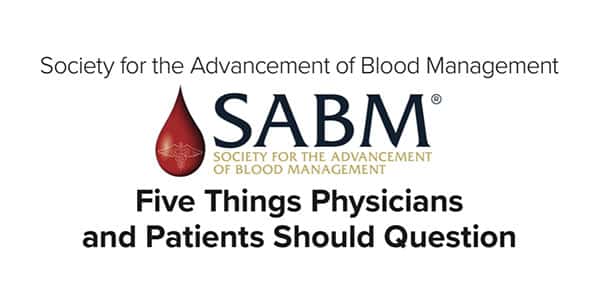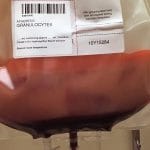Your Patient Blood Management program can be so much more! Carolyn Burns shows you how to make wiser PBM choices today.
NOTE: Continuing Education credit for this episode has expired. See below for details.

Dr. Carolyn Burns
Backing Up For a Second
There’s a pretty good chance that whatever your PBM program looks like, it could do much MORE. If you are monitoring transfusions for appropriateness, for example, how about diagnosing anemia earlier so that transfusion isn’t needed at all? Or what about using antifibrinolytics to stop bleeding before a patient even gets to the point of transfusion? Or, and this is a big one, does that patient REALLY need those daily lab draws? All of these issues (and more) are things that SABM believes all facilities should do better, and that’s the point of this interview.
My friend Dr. Carolyn Burns is a SABM Board Member, and an independent consultant for Patient Blood Management initiatives. She was intimately involved in developing the Choosing Wisely document. Carolyn joins me for a quick-moving discussion of some overall philosophies of PBM, and discusses each of the five questionable practices in detail.

Dr. Carolyn Burns
Backing Up For a Second
There’s a pretty good chance that whatever your PBM program looks like, it could do much MORE. If you are monitoring transfusions for appropriateness, for example, how about diagnosing anemia earlier so that transfusion isn’t needed at all? Or what about using antifibrinolytics to stop bleeding before a patient even gets to the point of transfusion? Or, and this is a big one, does that patient REALLY need those daily lab draws? All of these issues (and more) are things that SABM believes all facilities should do better, and that’s the point of this interview.
My friend Dr. Carolyn Burns is a SABM Board Member, and an independent consultant for Patient Blood Management initiatives. She was intimately involved in developing the Choosing Wisely document. Carolyn joins me for a quick-moving discussion of some overall philosophies of PBM, and discusses each of the five questionable practices in detail.
To me, the use of plasma outside of an exsanguinating hemorrhage protocol or for therapeutic plasma exchange for TTP…isolated orders for plasma should be questioned. They should be thought about very, very carefully, because most often they’re not needed.

About My Guest:
Carolyn Burns, MD is a Board-certified Anatomic and Clinical Pathologist. After earning her Microbiology degree from the University of Kansas, and her MD from the University of Missouri, Dr. Burns completed an internship in General Surgery followed by Pathology residency at the University of Louisville. She was Chief of Pathology for the Jewish Hospital Healthcare System Department of Pathology in Louisville, KY from 1991-2011. She has previously been an Assistant Clinical Professor in the Dept. of Pathology at the University of Louisville and on the Advisory Board and guest lecturer for the Bellarmine University Clinical Laboratory Science Program. Carolyn currently serves as a physician advisor for the American Red Cross Blood Center, River Valley Region.
Dr. Burns is an active member of several medical societies including AABB, College of American Pathologists, American Society of Clinical Pathologists (where she serves on the Education Committee), and the Society for the Advancement of Blood Management (SABM) where she serves on the Board as Treasurer and is the editor of the SABM Newsletter. Dr. Burns is a board member, as well, for the Kentucky Association of Blood Banks.
Dr. Burns is a passionate advocate for Patient Blood Management, has been published in peer-reviewed journals and textbooks, and is often sought as an engaging speaker on diverse transfusion topics.
Continuing Education Expired
This podcast episode offered continuing education credit for two years from its release date, but is no longer eligible for such credit.
To find Blood Bank Guy Essentials Podcast episodes with active continuing education opportunities, Click here or visit Transfusion News Continuing Education on Wiley Health Learning.
DISCLAIMER: The opinions expressed on this episode are those of my guest and I alone, and do not reflect those of the organizations with which either of us is affiliated. Neither Dr. Burns nor I have any relevant financial disclosures.
Further Reading:
- SABM Choosing Wisely List: From the SABM site.
- Consensus statement on pre-operative iron-deficiency anemia: Muñoz M et al. International consensus statement on the peri‐operative management of anaemia and iron deficiency. Anaesthesia 2017;72:233-247.
- CRASH-2 Trial: Summary in pdf book form
- WOMAN Trial: WOMAN Trial Collaborators. Effect of early tranexamic acid administration on mortality, hysterectomy, and other morbidities in women with post-partum haemorrhage (WOMAN): an international, randomised, double-blind, placebo-controlled trial. Lancet 2017;389:2105-2116.
- Article in 2002 Forming foundation of Choosing Wisely: Medical Professionalism in the New Millennium: A Physician Charter. Ann Intern Med. 2002;136:243-246.
Music Credit
Music for this episode includes “Cuando te invade el temor” and “Reflejo,” both by Mar Virtual via the Free Music Archive. Click the image below for permissions and license details.














Thanks for another great show. In the discussion regarding use of tranexamic acid, Dr. Burns referenced the use of intravenous or topical TXA. I don’t believe there was any specific mention of oral TXA. There is some literature suggesting that oral TXA may have similar efficacy in patients undergoing total joint procedures [Medicine (Baltimore). 2018; 97(36): e12270.] This route of administration is less costly than parenteral therapy. Any thoughts?
Also, I’m wondering if you have any information about when results from the Halt It Trial (looking at the utility of TXA in management of upper GI bleeders) might be available.
Thanks again,
Bruce Jobe
Bruce, You are certainly correct that oral TXA is available and has been the topic of several recent studies, including the one you list. I certainly feel that encouraging these types of studies that show equivalence to IV or topical are excellent and help to ensure we are considering appropriate use/incorporation of antifibrinolytics. Thank you for mentioning this as each institution/system must evaluate their needs and availability when implementing their PBM best practices.
As for the HALT-IT trial, I have not seen any data published to date. Certainly many of us anxiously await these results. The same should be noted re: the CRASH3 trial re: use of TXA in TBI. If any other colleagues out there have more updated information, please share if possible!
Thank you Bruce for participating and providing comments/queries. Best, Carolyn
Great Podcast! Very much enjoyed the discussion. Dr. Burns mentioned patients with blood transfusions showing increased 30-day mortality and increased length of stay, what are the best references to use to convince our physicians of this?
Thanks!
-Jeff M
Jeff, So glad you enjoyed the podcast and found it useful. As for publications which speak to the increased morbidity and mortality associated with transfusions, there are a multitude of these. I would recommend that you review the PBM-themed issue in Anesthesia Analgesia Fall 2022.
This issue has studies re: increased LOS, HAIs, readmission rates unit for unit, the ethics and economics of PBM, the global definition of PBM, bloodless care and outcomes, informed consent/informed choice and so much more. It is the Sept. 2022 issue, volume 135, number 3. Each article is filled with excellent references. Share with your colleagues!
I also invite you to join SABM. We have so many excellent resources. Would love to see you @ our Oct. 4-7th Annual Meeting in Nashville! Best, Carolyn